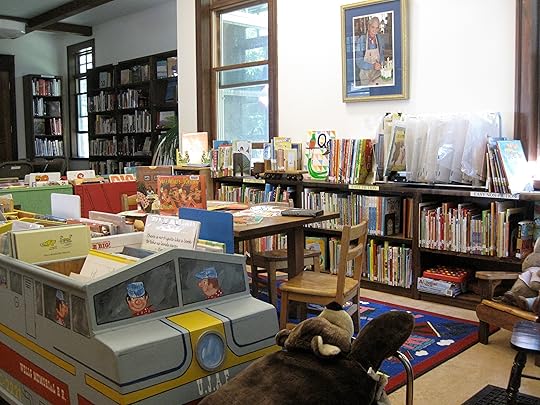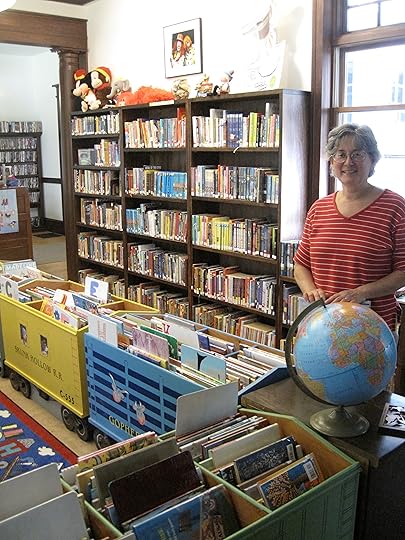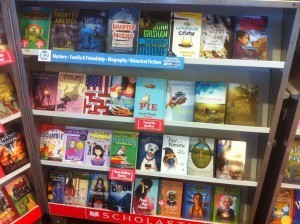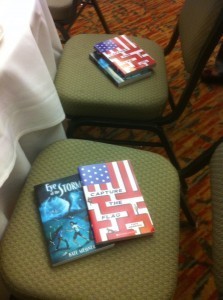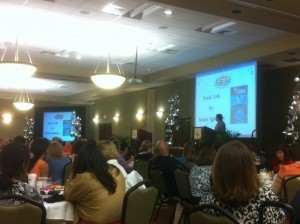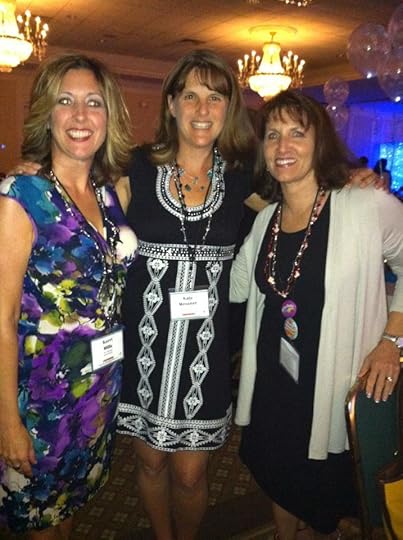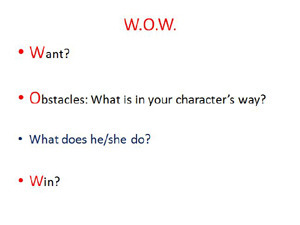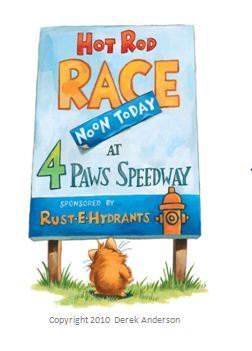Kate Messner's Blog, page 8
September 23, 2012
Real Revision: Creating the tools we need
Necessity is the mother of invention, right? I’m not sure who said that (I think Plato gets credit for it sometimes) but I’ve found that the saying is true when it comes to revising a book. So often, I’ll get to a stage in the revision process when I know I need to try a different strategy. But deep as my revision toolbox may be, I can’t always find the right thing. Sometimes, writers need to invent the tools they need to figure things out.
Which brings me to the Timeline-Treatment-Symptom-Belief-Emotion chart…
Last week, I was finishing up revisions on WAKE UP MISSING, my fall 2013 MG science thriller with Walker Bloomsbury, and I realized that I needed to do one more pass to check on the progression of some elements of the story. The novel is about four kids with post-concussion syndome who leave home hoping for a medical miracle. But when they’re admitted to an elite neurology clinic at a former military base in the Everglades, things don’t seem quite right, and little by little, they learn that the clinic’s goals have evolved beyond curing head injuries. The book takes place over eight days, and I created the chart above to track the changes that take place from chapter to chapter and day to day. One thing that was important was making sure that the narrator’s concussion symptoms were consistent with her treatment.
On many levels, this book is about changes, so it was also important to make sure I understood how my main character’s beliefs changed and how her emotions evolved through the course of her experience.
Chapter by chapter, I read through my draft and filled in the chart. I noticed a lot of small things along the way, and I made a couple important discoveries, too . I kept a running list of changes to consider after I finished charting everything, and then I went back for one more revision pass.
This is messy stuff and probably doesn’t make much sense to you as a reader, but as a writer, I can step back and see the bigger picture here — just what’s happening, just where things are moving too quickly or not quickly enough, just where a shift in view doesn’t sit quite right, and that’s where the text needs work.
Because I am a revision geek at heart, this was a deeply satisfying process and — I’m just going to say it — really, really fun. But even if you don’t love revising, getting out the big paper and colored pens can help you see your story in a new way.
Sadly, I’ll probably use this particular revision tool just once in my writerly life. After all, how many books can an author really write that might make use of a timeline-treatment-symptom-belief-emotion chart? But the experience has reinforced one lesson for me — that every book demands new tools, and if they don’t already exist in your bag of tricks, you just may need to invent them.
.
September 21, 2012
Teachers Write: Sometimes, when I write…
Saturday, October 20th is NCTE’s National Day on Writing. How will you celebrate?
It strikes me that this is not only a great excuse to hunker down somewhere with a big mug hot chocolate and notebook or laptop but also an opportunity to share.
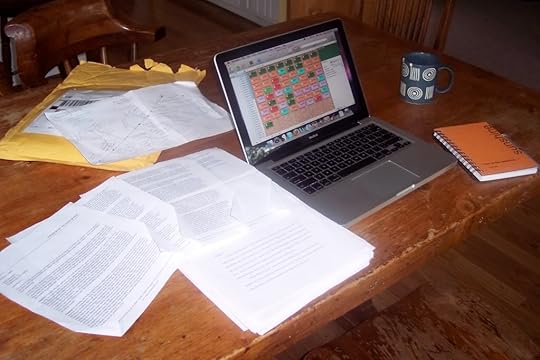
If you’re a writer at heart, it’s tough to understand how anyone could live without putting pen to paper or clicking away some at a keyboard each day. But plenty of people — lots of kids — can’t understand why we’d want to do that at all. On October 20th, might we open a window into our writing lives so that people who don’t understand the value can have a glimpse of what this world is like?
Today: You can write whatever you want — a free verse poem, a memoir, a short story or monologue, a letter. Start with this line:
“Sometimes, when I write..”
See where it goes. Think about sharing this one with your students and inviting them to do the same. The week of October 20th, we’ll be celebrating writing with a special project on my blog. This will get you (and hopefully your students!) thinking in the right direction to join the celebration.
For today, feel free to share a snippet in the comments if you’d like!
And by the way, you don’t have to be a teacher or librarian to join us in sharing today… We’d love to hear from authors and kids and nurses and accountants and everybody, too!
.
September 13, 2012
Teachers Write: If Characters Ruled the Land
If you’re new to Teachers Write, you can read all about it here. Then join us for today’s prompt!
Even the true political junkies among us need a break from Barack and Mitt now and then, so we’re going to talk a different kind of politics today. I love the Horn Book’s KidLit Election project, where they’ve invited folks to nominate their favorite fictional characters as Democratic or Republican candidates for the U.S. Presidency. Personally, I’m partial to this one…
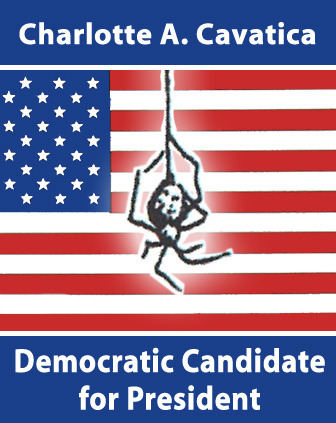
From The Horn Book, http://www.hbook.com/2012/09/blogs/ou...
But there have been many great arguments made for not only spiders but also slaves and ADHD kids in the Oval Office. Which brings me to this week’s writing prompt.
Imagine your favorite fictional character running for President (or Prime Minister, or whoever’s in charge where you live). Write his or her (or its?) speech to accept the nomination, being sure to both inspire supporters and outline a clear platform of beliefs and promises.Keep it positive (the Horn Book made this rule, and I like it… let’s not have Voldemort representing either party, please). And consider what kinds of beliefs your character has and how those might shape political policy. Have fun, but be thoughtful, too.
You may also want to try this with a character from one of your own works-in-progress. Running for office really forces you to examine what you believe and how far you’re willing to go to fight for it, I suspect. Interesting stuff to ponder, wearing our characters’ shoes.
Feel free to share your speeches in the comments. I’m guessing some of you may want to try this one out in the classroom once you’ve played around with it yourself, and I’m sure kids will enjoy your examples, as well as those posted on the Horn Book’s site.
.
September 9, 2012
Wells Memorial Library – What a Difference a Year Makes
Last September, after Tropical Storm Irene tore through the Adirondacks, the children’s section of Wells Memorial Library looked like this.

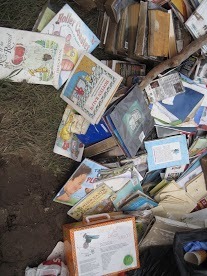
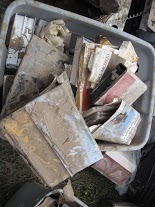
The storm sent flood waters surging into the library’s basement and first floor children’s room, and they lost their entire children’s collection. I took photos and blogged about it here, and I tweeted and Facebooked, along with a lot of other folks, to see if people wanted to help. They did.
Donations poured in — books and money from all over the United States and beyond. The Bookstore Plus, a nearby indie, hosted this fundraiser that raised even more funds for the devastated library. And today, the Wells Memorial Library children’s section looks like this.
My daughter and I stopped by to visit on our way hiking last week, and we were just amazed by the transformation — the result of many, many hours of hard work from volunteers, board members, and library director, Karen Rappaport. Here’s Karen with all the new books…
She says a HUGE thank you to all of you who donated books and money and helped to spread the word of a library that needed a hand. Thanks to you, this library is back on its feet and sharing even more books with readers.
.
August 26, 2012
Paris Research for MANHUNT (Spring 2014)
I’ve been juggling a number of projects this summer, but I’ve spent the past week immersed in a book I haven’t started writing yet. MANHUNT (coming in Spring 2014) is the third title in my Silver Jaguar Society mystery series with Scholastic. It’s a follow-up to CAPTURE THE FLAG (July 2012) and HIDE AND SEEK (coming in April 2013). Like the first two books, MANHUNT features Anna, José, and Henry – three twelve-year-old kids whose families are part of a secret society bound to protect the world’s artifacts.
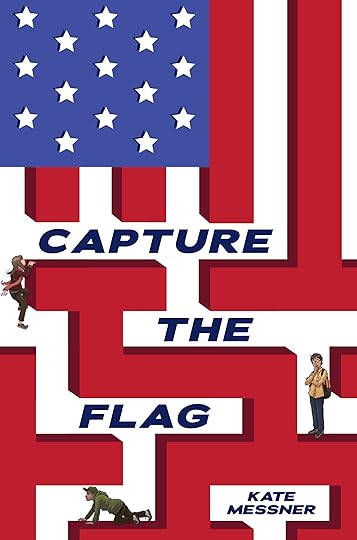
In their first adventure, CAPTURE THE FLAG, the original Star-Spangled Banner is stolen from the Smithsonian, and the kids race through a snowed-in D.C. airport trying to track down the thieves.
In HIDE AND SEEK, Anna, José, and Henry and their families will explore the rainforest of Costa Rica as they search for a stolen goblet that’s also a sacred piece of Silver Jaguar Society history.
And in the third book, MANHUNT, Anna, José, and Henry will again come face to face with the the Silver Jaguar Society’s arch enemies during a multi-faceted, international heist that begins in Boston and ends here…

Yep – I’ve been “working” in Paris for the past week. (I’m pretty sure you are required to include quotation marks around the word “working” when your week has also included consuming Nutella-banana crepes and copious amounts of gelato.)
When it comes to this trip, I’m going to save my words for the book I’ll be writing this fall and winter…but here are a few photos to give you some hints about Anna, Henry, and Jose’s third adventure!








I’m headed back to my writing room now…
.
August 17, 2012
Thank you, Scholastic Book Fairs!
August is a busy time for the Scholastic Book Fair teams who set up carts and carts of books in schools all over the country. Titles for the fall fairs have been selected, and it’s time for the field representatives to learn everything they can about the books so that they can help teachers & librarians find “just right” books for their students. I’m writing in the Charlotte, NC airport right now after spending the past couple days at Scholastic’s Eastern Zone Season Kick-Off meeting, and I’m still swimming in happy book-talk feelings.
I got a sneak peek at the fall Book Fair titles and spotted three of my own books as well as many that I’ve loved as a reader.
And I had the opportunity to speak to the Scholastic Book Fairs team, too. There’s nothing quite like arriving for an early-morning breakfast to find this…
..along with books on every chair.
I got to meet so many members of the Book Fairs team, along with a special guest…
This is Book-Man (aka Mike Weaver, a principal from New Jersey who’s part of Scholastic’s principals’ advisory board.) He’s an incredible advocate for literacy at his school and left me wishing that every school could have a Book-Man in the main office. (Plus, I’ve never had my picture taken with a super-hero before, and that was pretty cool.)
Here’s Robin Hoffman of Scholastic Book Fairs book-talking EYE OF THE STORM before my talk. She did such a great job, she made ME want to read it again. And I already know how it ends.
I was so thankful for the opportunity to spend time with the book fair crew, both here and in St. Louis last week. Growing up in a small town with no bookstore, I was always bursting with anticipation on the day our Scholastic Book Club orders arrived at school. Overnight, it seemed, our classroom was transformed into a bookstore, and it always felt like magic. These days, my books are included in the clubs and fairs, but inside, I’m still very much that ten-year-old kid, and it still feels like magic. Traveling to St. Louis last week and then Charlotte, and meeting the wizards who make it all happen was pretty magical, too. Thanks, Scholastic Book Fairs family, for the warm welcome and for all that you do for readers!
.
August 14, 2012
Teachers Write! Revision Chat
I want to start this post with a confession. I am not a great writer. In fact, I am frequently a pretty awful writer who pens first drafts full of clunky prose and tired language. Sometimes I turn a Monday into a Wednesday in the middle of a chapter (this, in a book that is not supposed to include magic), and sometimes my characters don’t know their own names, much less their motivations.
So how have I managed to get a bunch of books published and even convince people that some of them should win awards?
I am a really passionate, enthusiastic reviser. When I do school visits, I always tell kids that revision is my favorite part of the writing process because that’s when I actually feel like I’m GOOD at this writing thing. When I’m drafting? Not so much. But once that draft is down, I always feel ready to roll up my sleeves and make something of the mess. That process, for me, is full of wonder and discovery and hope. So I’m a big believer in the magic of revision, and I wanted to set aside a #TeachersWrite day to celebrate it.
Author friends: We’d love to hear from you. If you have a favorite revision strategy, or advice on the revision process, or a post about revision that you’d like to share, please leave a comment and join the conversation.
Teacher & Librarian friends: I know that some of you have read my book for writers & teachers of writers, REAL REVISION: AUTHORS’ STRATEGIES TO SHARE WITH STUDENT WRITERS, and I’m more than happy to answer questions about that in the comments today. And whether you’ve read it or not, please fire away with any other questions you’d like answered when it comes to revision. And please feel free to share your revision experiences from this summer, too.
Here some revision resources you may find helpful for your teaching and writing:
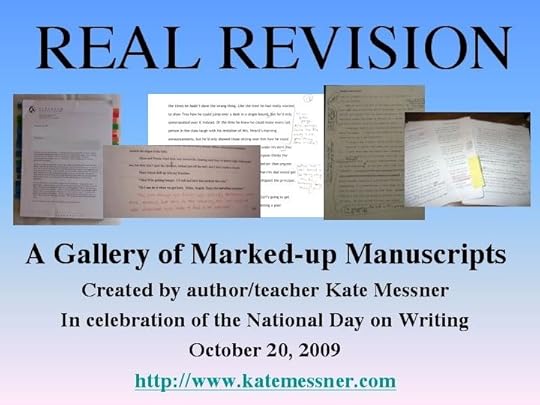
Revision Gallery – A Collection of Marked Up Manuscripts
What Revision Looks Like – A Pinterest Board
REAL REVISION home page with links to Kate’s two videos on revision
65 Off-Draft Writing Prompts to Kick-Start the Revision Process
REAL REVISION Interview with Lauren Oliver
REAL REVISION Interview with Lisa Schroeder
REAL REVISION Interview with Jo Knowles
REAL REVISION Interview with Linda Urban
REAL REVISION Interview with Laurel Snyder
REAL REVISION Interview with Karen Day
Comments are open – let’s talk revision! And on Wednesday night (8/15), we’ll also talk revision on Twitter with a chat from 9-10pm EST, using the hashtag #RealRevision.
.
On the Road in August
Well, hi there! It’s good to see you…and good to see my living room again, too. August has been a busy month so far, full of travel and terrific people. Here are some highlights.
At the beginning of the month, I flew out to Los Angeles for the annual SCBWI Conference (that’s the Society of Children’s Book Writers & Illustrators, for the uninitiated) because OVER AND UNDER THE SNOW won the Golden Kite Award for Best Picture Book Text, which was…well…amazing. This award comes from fellow authors, so it means so, so much. Here’s a photo of me speaking to 1200+ people at the awards luncheon. (I love still photos because they don’t show shaking hands.)
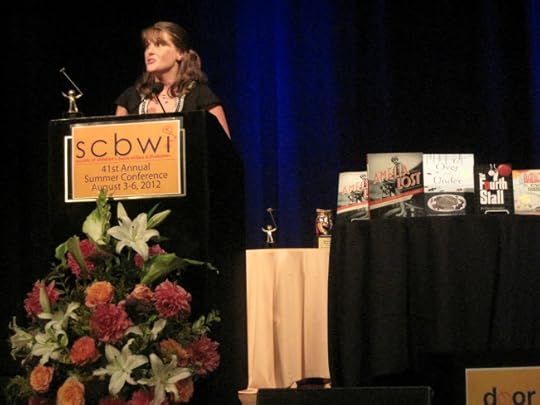
I was also part of the faculty for this conference, giving a presentation called “Picture Books: The Magical Unexpected.” I talked about lots of picture books that I love and how they all incorporate different kinds of “unexpecteds.” You can see the list of books I talked about here.
The most amazing thing about this conference was getting to spend time with other children’s writers and illustrators. Lin Oliver, executive director of SCBWI, likes to refer to the big mob of creativity as “the tribe,” and it’s such a great description because coming to a conference like this really feels like coming home. Here’s a photo of Lin welcoming the group.
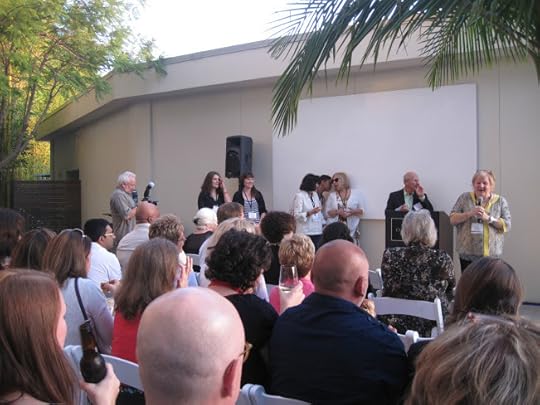
And here’s a photo of a children’s author snapping a photo of her stuffed Peep with Lin.
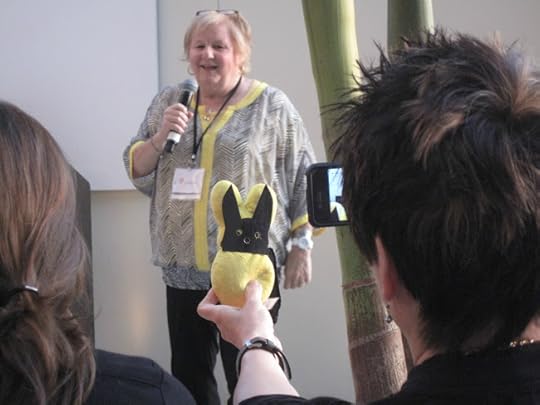
Can you identify the mystery author with the mystery Peep? (If you give up, you can click here to find out.)
My family came with me on this trip, and we also managed to sneak in some classic California fun like this tour of Hollywood and Beverly Hills. Do you recognize this famous landmark?

We didn’t either. But it is apparently Tom Cruise’s flag. “And if you look carefully,” our driver said, pointing, “you can kind of see his chimney, too.”
From L.A., I flew straight to Pennsylvania, where I spoke at the PA Writing Institute at Millersville University. This is a five-day institute full of incredible teacher-writers who dedicate their week to practicing what they preach.
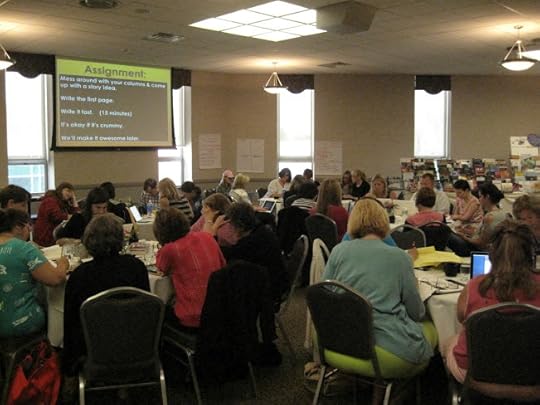
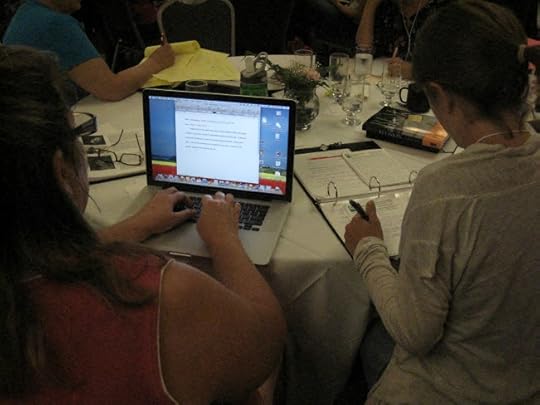
They were an amazingly kind, smart, and creative group, and I wish I could have spent a full week writing with them!
I ran into a little snafu with the TSA on my flight home from LA and Pennsylvania. The agents pulled my suitcase aside for searching, and they asked if there was “something sharp” in there.
“Well,” I said, “I won this award, and it has a kite that’s maybe a little pointy.”
They unpacked it and studied it and frowned at it for a little while.
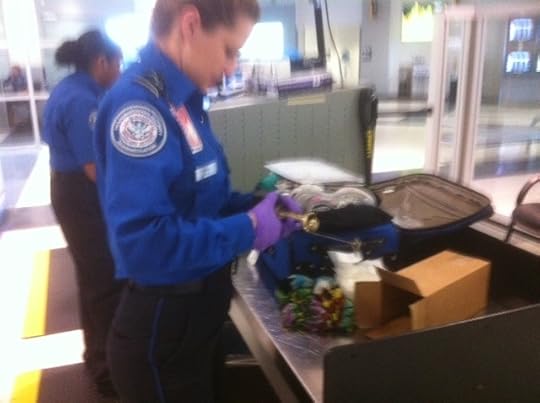
Finally, one agent said, “What’s Over and Under the Snow?”
“It’s a…picture book.”
“Did you write it?”
“Yes. I did.”
(More frowning & studying.)
“We’re going to run this through the machine once more.”
They did. And then they swiped it to check for explosives but found none, I gather, since I was allowed to take it home.
After a day’s break, I flew to St. Louis to be the guest author at the Scholastic Book Fairs seasonal kick-off meeting for that region. When I was a kid and the Scholastic Book Club orders arrived, I was always under the impression that something magic must have happened overnight in my classroom. Book Fairs came along later on and work that same magic now, in so many communities like mine that don’t have their own bookstores. It was so much fun to meet the people (the wizards!) who make this happen for kids and classrooms.
Here I am with my fantastic (and fun!) Scholastic Book Fairs hosts, Kerri Mills and Rose Schovanec. (Photo from Kerri’s FB page – thanks, Kerri!)
I’ll be visiting another Scholastic Book Fairs kick-off meeting in Charlotte later this week, then taking a research trip for book #3 in the Silver Jaguar Society mystery series, and then – home to finish summer deadlines and get the kids ready for a new school year. Hope your August has been full of sunshine and magic, too!
.
August 5, 2012
Teachers Write 8/6 Mini-Lesson Monday
Good morning! ______, you won the drawing for Caroline Rose Starr’s book, MAY B. Please email me (kmessner at kate messner dot com) with your mailing address so she can send your book.
Today’s Mini-Lesson Monday features guest author Cynthia Lord, who is not only a Newbery Honor author (for RULES) but also a super-nice person and brilliant teacher, too. I have learned so much about writing just from reading Cindy’s blog.
Her debut novel, Rules, was a New York Times Bestseller and has received numerous awards, including a Newbery Honor and six state kids’ choice awards. A former elementary and middle-school teacher, Cynthia even spent a year teaching in a tiny school on a Maine island, the setting for her second novel, Touch Blue. She is also the author of a picture book series, Hot Rod Hamster, illustrated by Derek Anderson. She lives with her family in Maine. www.cynthialord.com. Cindy’s joining us at Teachers Write today and Wednesday to talk about plotting.
When I do school visits, I always meet kids who love to write. They come up to me, gripping their notebooks full of fabulous ideas. They have done impressive work imagining the characters and their world, but they often struggle with the plot. How do you set up a story, keep it going with steadily increasing tension, and pay it off for the reader?
To talk about plot, we must also talk about character, because they’re like two strands of a rope twisting around each other, strengthening both. One informs the other. So to help students understand story development, let’s start with a classic plot that has a character with a want or a goal.
With students as young as first grade, I use this simple formula:
What does your character want?
What makes it hard for him?
What will he do trying to get what he wants and deal with that obstacle?
And finally, does he get what he wants?
The first two (want and obstacle) are set up very early in a book, because they set the path of the plot. Here’s the first page of Hot Rod Hamster. The illustrator, Derek Anderson, created this wonderful sign.
Before we’ve even read a word of text, this picture sets the plot in motion. We have everything we need for a story to begin: a character (Hamster), a want (to enter and win a race), and an obstacle (he’s tiny).
We also know something about the climax–because that’s where we’ll discover if the character got what he wanted. So if Hamster wants to enter and win a race at the beginning of the story, the climax will be at the race where we find out if he won.
The rest of the story is what comes between: how the character tries to get what he wants and deal with his obstacles to that big, deciding moment.
For young students, that’s enough to begin. But for older students and adult writers, let’s expand that W.O.W. to include motive. So the character truly wants two things (or more, but they fall into these two categories): concrete and abstract.
Concrete: a concrete want is what the character wants outside himself. Here are a few examples:
•To earn enough money for something.
•To make the football team.
•To have a friend.
•To reach New York City.
•To win a contest.
•To learn to swim.
•To find a lost pet.
•To save his home.
•To solve a mystery.
Usually this can be answered with a “yes” or “no” at the climax. Either the character achieved this or he didn’t. So it must be big enough and challenging enough to last for the entire book. The reader will measure progress against the concrete want. It also sets the path of the story, defines the climax, and controls the pacing. Without a strong concrete want, the book will feel slow. Editors (and kids) will say things like: “I’m not sure what this story’s about.”
When I’m working with students, I show a slide with photos of kids doing actions or obviously involved in something (playing soccer, wearing a prom dress, dancing with a group on a stage, hugging a dog, etc). I ask students to choose a photo and tell me what that character might want.
Then I ask students to come up with another want for the same character. Sometimes I’ll even ask them to imagine the opposite want for the character (What if this girl doesn’t want to go to the prom? What might she want then?) and how that changes things and adds immediate conflict. Our first ideas aren’t always our most interesting ones, and by making kids look for more than one possibility right from the start, it encourages a revision mindset, more open to change.
Now that we’ve thought about what a character wants, the next question is why?
Abstract: an abstract want is what the character wants inside himself. It’s the reason why. Here are a few examples:
•To find their place in their family.
•To understand where they fit into their culture.
•To be accepted and valued for themselves.
•To belong or fit in.
•To feel loved.
Your character will make progress on this in the story, but it’s moving along a continuum, more than a yes or no. The abstract want began before the book started, gives depth to the character, motivates his decisions, shows his flaws and strengths, and makes the reader care about the character winning. Without a strong abstract want, the story will lack character development. Editors will say things like, “I didn’t really connect with the character.”
A strong story has both wants. Your character will want something outside himself for a reason inside. Here’s a classic plot set-up:
My character wants (concrete want) because (abstract want), but (obstacle) stands in his way.
Not every novel follows this format, but most do, and it does produce a strong, satisfying setup.
Ready to practice? Jody Feldman’s random word generator was so much fun that I found one for YA characters. http://selfpublishingteam.com/chargen/ya/ You can set limits or be surprised! As an example, I let the program choose everything.
Name: Ethan
· Age: 12-13 (8th Grade)
Ethan’s Traits
· Book worm.
· Cruel, Brilliant, Lucky
· Unique Trait: Is famous.
Ethan’s Appearance
· Hair Color: Black
· Eye Color: Brown
· Body Type: Skinny
Looking at this, I asked myself, “How might a middle-school bookworm be famous?” I brainstormed three scenarios:
#1 Ethan writes fan-fiction, and he’s famous in that world, though he writes under a pen name so no one at school knows who he is.
#2 Ethan’s famous because his dad is a rock star who wrote a hit song about him when he was a baby, and the world knows him that way. “Oh, you’re Baby Ethan?!”
#3 Ethan’s famous in a school sense: He’s captain of his school’s Battle of the Books team. Last year his team went all the way to second place at the state championship.
I would encourage you to brainstorm a few to encourage a revision mindset in yourself. Then pick your favorite and create a plot statement.
(Character) wants (concrete want) because (abstract want), but (conflict) stands in the way.
Here’s mine: Ethan wants to win the Battle of the Books State Championship, because he longs to feel valued at home and school, but some reluctant-reader teammates stand in his way.
Fleshing that out to a summary:
Ethan wants to win the Battle of Books State Championship, because his younger brother has won many sports awards and Ethan wants his own chance to shine. As an eighth grader, this is his final year to compete, and last year, his team lost to Maplewood Middle School. The Maplewood captain goes to the same church as Ethan, so he sees him every week. Ethan’s been daydreaming about winning this year, but at the first meeting, his team’s faculty advisor brings some kids with her who aren’t strong readers. “This will be a great opportunity for them!” she says. Ethan knows he’ll never win with those kids on his team.
That has everything a plot needs to begin: a character, a concrete want that we’ll measure progress on (the championship), an abstract want that makes us care (wanting to feel valued and special for his own talents), and an obstacle (challenging teammates) to create tension.
Assignment: Create a character. If you don’t connect with the first character you receive, try again. Or use a character you’ve already created–though it might be easier to practice first with someone you aren’t as invested in.
In the comments, post a quick description of your character and your favorite plot statement or summary. If you get stuck or want help brainstorming, post as far as you get, and I’ll ask questions that’ll help you finish it. I’m excited to meet your characters and read your ideas!
(And on Wednesday, I’ll give tips on: starting your story, increasing tension, and paying it off).
.
August 1, 2012
Teachers Write: Hummingbirds on a Wednesday
Guest author Amy Ludwig VanDerwater joins us today with a guest post on a very important part of writing: Inviting Hummingbirds! Amy lives on Heart Rock Farm (The Poem Farm) in Holland, NY. Her first poetry book, FOREST HAS A SONG, will be published by Clarion/Houghton Mifflin Harcourt (Spring 2013) and her second book, READING TIME, will be published by WordSong/Boyds Mills Press (date TBA). In addition to poetry, Amy has written local NPR commentaries as well as a column for EDIBLE BUFFALO.
 The other morning, as most of the house slept, our ten-year-old son Henry came running downstairs with wild eyes,
The other morning, as most of the house slept, our ten-year-old son Henry came running downstairs with wild eyes,
“There’s a hummingbird in my room! There’s a hummingbird in my room!”
I followed him upstairs, rubbing his back, smiling about my boy and his hummingbird dreams.
When we reached Henry’s bedroom, I heard the truth before I saw it. There, whirring against the inner screen of his skylight darted a little green beauty. This was not a dream. It was better than a dream. As I gently caught Zippy in a polka-dotted sheet, Henry cranked the window above his headboard. “I must have left it open all night.” Laughing in wonder, we walked downstairs and onto the deck, opening this delicate sheeted gift to our morning, sending Zippy back to her life.
Writing is full of hummingbirds, surprises that we almost miss or think aren’t real enough to matter. And these hummingbirds are whirring too; sometimes we just need to still ourselves enough to hear them.
When I get to a stuck spot in my writing, I invite a hummingbird.
How?
I turn off all phones, lie on the couch, and close my eyes. I breathe deeply and wait. And you know what? A hummingbird always comes. It might be a memory of curling dandelion stems in dish soap or a memory of sweet Mr. Clark singing “Once in love with Amy.” It may be the sound of a skipping stone or a recipe for cardamom bread or the feel of milkweed silk or a word that’s fun to say…like flibbertigibbet. A hummingbird.
When I am writing in rhythm, daily and with daily goals, there are days that my page and mind need to wander in colorful meadows before walking across a blank page. And so I still my body and hold out my hands, trusting….always…in surprises. And then, bird in hand, I go back to my desk.
Have I ever fallen asleep? Yes. And you may too. But dreams, too, inform our writing lives.
Whirr.
.




